Knowledge Management Case Study: MITS5505 Take Home Exercise Solution
VerifiedAdded on 2022/11/01
|11
|1948
|246
Homework Assignment
AI Summary
This assignment provides a detailed solution to a knowledge management case study, addressing various aspects such as brainstorming, the nominal group technique, and consensus decision-making to solve employee perception issues. It includes the codification of knowledge using frames for a horse, a student, and an airline pilot, and discusses the effectiveness of different knowledge developer approaches. The assignment also analyzes the implementation of knowledge management (KM) in an organization, highlighting the potential failures at different stages of KM adoption and providing insights into the importance of KM for organizational success. The solution covers both explicit and tacit knowledge, offering recommendations for knowledge development and management strategies, with references to relevant literature.
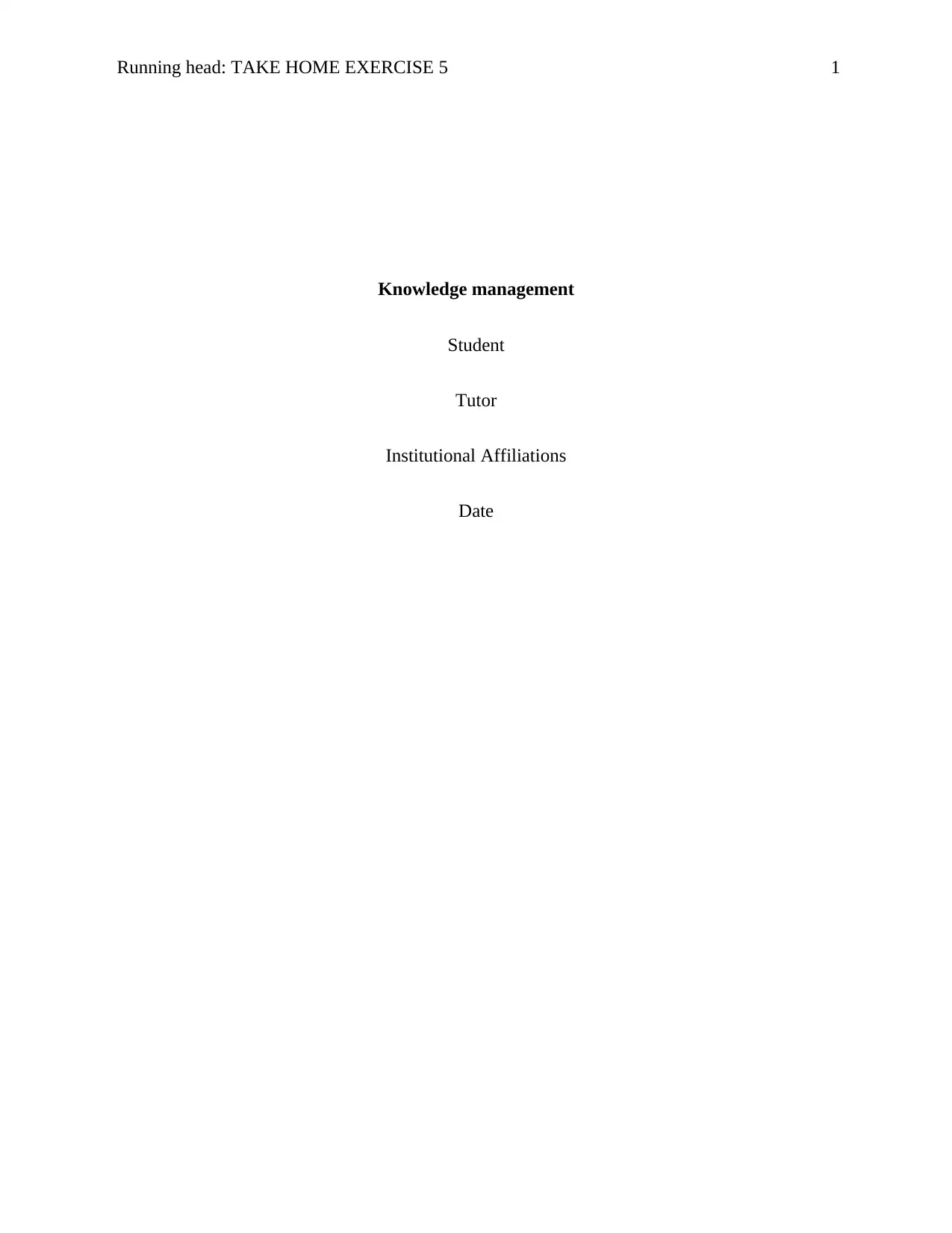
Running head: TAKE HOME EXERCISE 5 1
Knowledge management
Student
Tutor
Institutional Affiliations
Date
Knowledge management
Student
Tutor
Institutional Affiliations
Date
Paraphrase This Document
Need a fresh take? Get an instant paraphrase of this document with our AI Paraphraser
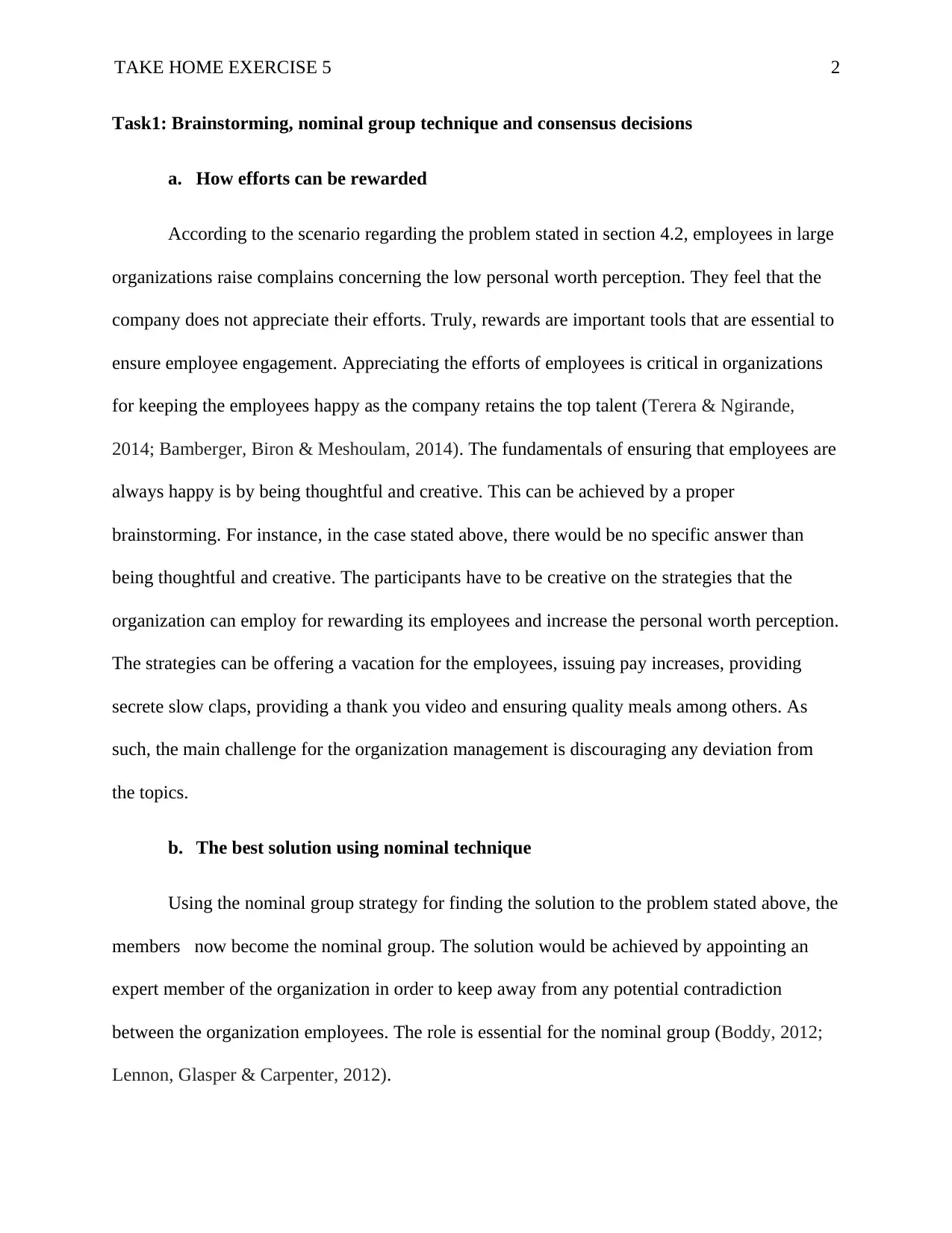
TAKE HOME EXERCISE 5 2
Task1: Brainstorming, nominal group technique and consensus decisions
a. How efforts can be rewarded
According to the scenario regarding the problem stated in section 4.2, employees in large
organizations raise complains concerning the low personal worth perception. They feel that the
company does not appreciate their efforts. Truly, rewards are important tools that are essential to
ensure employee engagement. Appreciating the efforts of employees is critical in organizations
for keeping the employees happy as the company retains the top talent (Terera & Ngirande,
2014; Bamberger, Biron & Meshoulam, 2014). The fundamentals of ensuring that employees are
always happy is by being thoughtful and creative. This can be achieved by a proper
brainstorming. For instance, in the case stated above, there would be no specific answer than
being thoughtful and creative. The participants have to be creative on the strategies that the
organization can employ for rewarding its employees and increase the personal worth perception.
The strategies can be offering a vacation for the employees, issuing pay increases, providing
secrete slow claps, providing a thank you video and ensuring quality meals among others. As
such, the main challenge for the organization management is discouraging any deviation from
the topics.
b. The best solution using nominal technique
Using the nominal group strategy for finding the solution to the problem stated above, the
members now become the nominal group. The solution would be achieved by appointing an
expert member of the organization in order to keep away from any potential contradiction
between the organization employees. The role is essential for the nominal group (Boddy, 2012;
Lennon, Glasper & Carpenter, 2012).
Task1: Brainstorming, nominal group technique and consensus decisions
a. How efforts can be rewarded
According to the scenario regarding the problem stated in section 4.2, employees in large
organizations raise complains concerning the low personal worth perception. They feel that the
company does not appreciate their efforts. Truly, rewards are important tools that are essential to
ensure employee engagement. Appreciating the efforts of employees is critical in organizations
for keeping the employees happy as the company retains the top talent (Terera & Ngirande,
2014; Bamberger, Biron & Meshoulam, 2014). The fundamentals of ensuring that employees are
always happy is by being thoughtful and creative. This can be achieved by a proper
brainstorming. For instance, in the case stated above, there would be no specific answer than
being thoughtful and creative. The participants have to be creative on the strategies that the
organization can employ for rewarding its employees and increase the personal worth perception.
The strategies can be offering a vacation for the employees, issuing pay increases, providing
secrete slow claps, providing a thank you video and ensuring quality meals among others. As
such, the main challenge for the organization management is discouraging any deviation from
the topics.
b. The best solution using nominal technique
Using the nominal group strategy for finding the solution to the problem stated above, the
members now become the nominal group. The solution would be achieved by appointing an
expert member of the organization in order to keep away from any potential contradiction
between the organization employees. The role is essential for the nominal group (Boddy, 2012;
Lennon, Glasper & Carpenter, 2012).
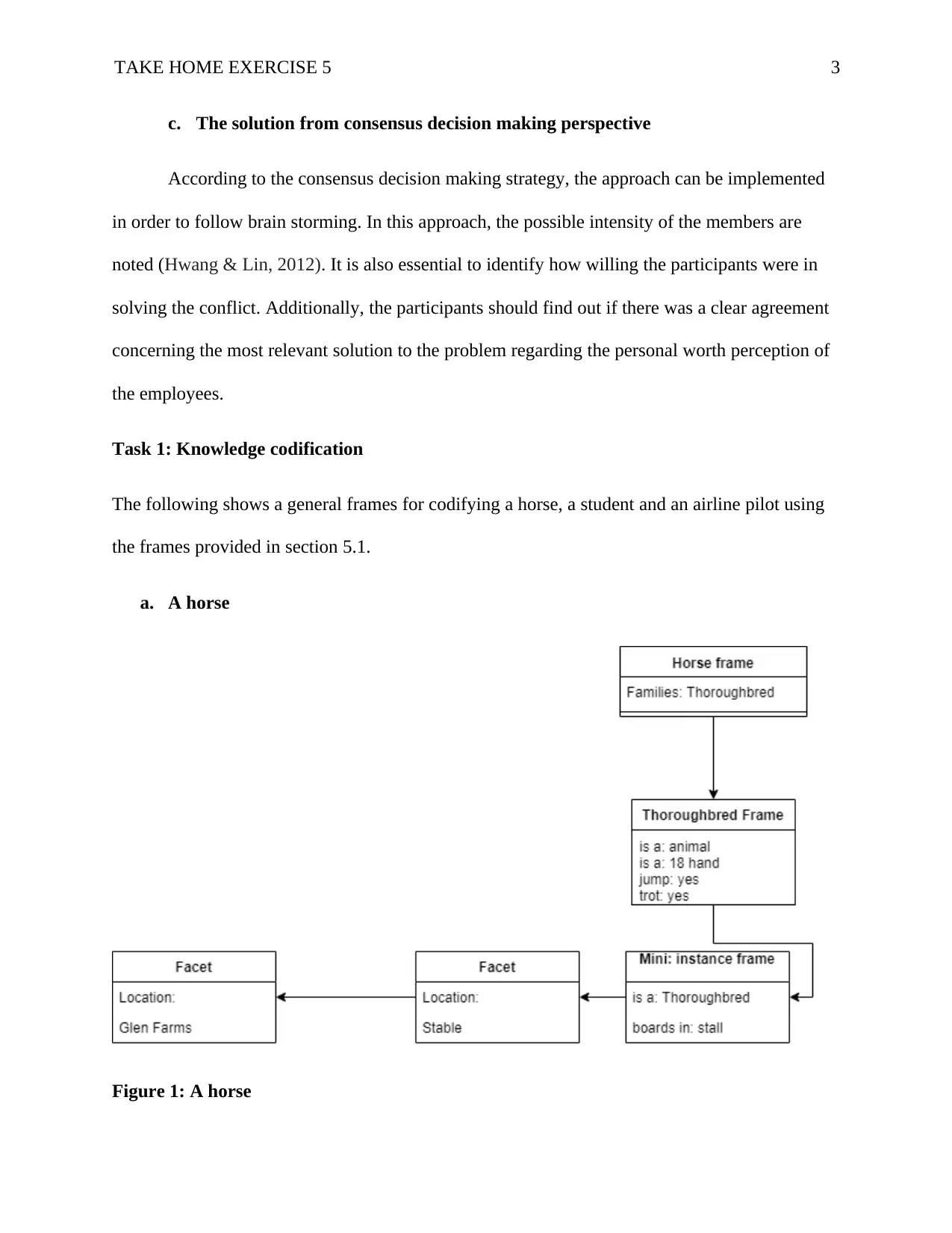
TAKE HOME EXERCISE 5 3
c. The solution from consensus decision making perspective
According to the consensus decision making strategy, the approach can be implemented
in order to follow brain storming. In this approach, the possible intensity of the members are
noted (Hwang & Lin, 2012). It is also essential to identify how willing the participants were in
solving the conflict. Additionally, the participants should find out if there was a clear agreement
concerning the most relevant solution to the problem regarding the personal worth perception of
the employees.
Task 1: Knowledge codification
The following shows a general frames for codifying a horse, a student and an airline pilot using
the frames provided in section 5.1.
a. A horse
Figure 1: A horse
c. The solution from consensus decision making perspective
According to the consensus decision making strategy, the approach can be implemented
in order to follow brain storming. In this approach, the possible intensity of the members are
noted (Hwang & Lin, 2012). It is also essential to identify how willing the participants were in
solving the conflict. Additionally, the participants should find out if there was a clear agreement
concerning the most relevant solution to the problem regarding the personal worth perception of
the employees.
Task 1: Knowledge codification
The following shows a general frames for codifying a horse, a student and an airline pilot using
the frames provided in section 5.1.
a. A horse
Figure 1: A horse
⊘ This is a preview!⊘
Do you want full access?
Subscribe today to unlock all pages.

Trusted by 1+ million students worldwide
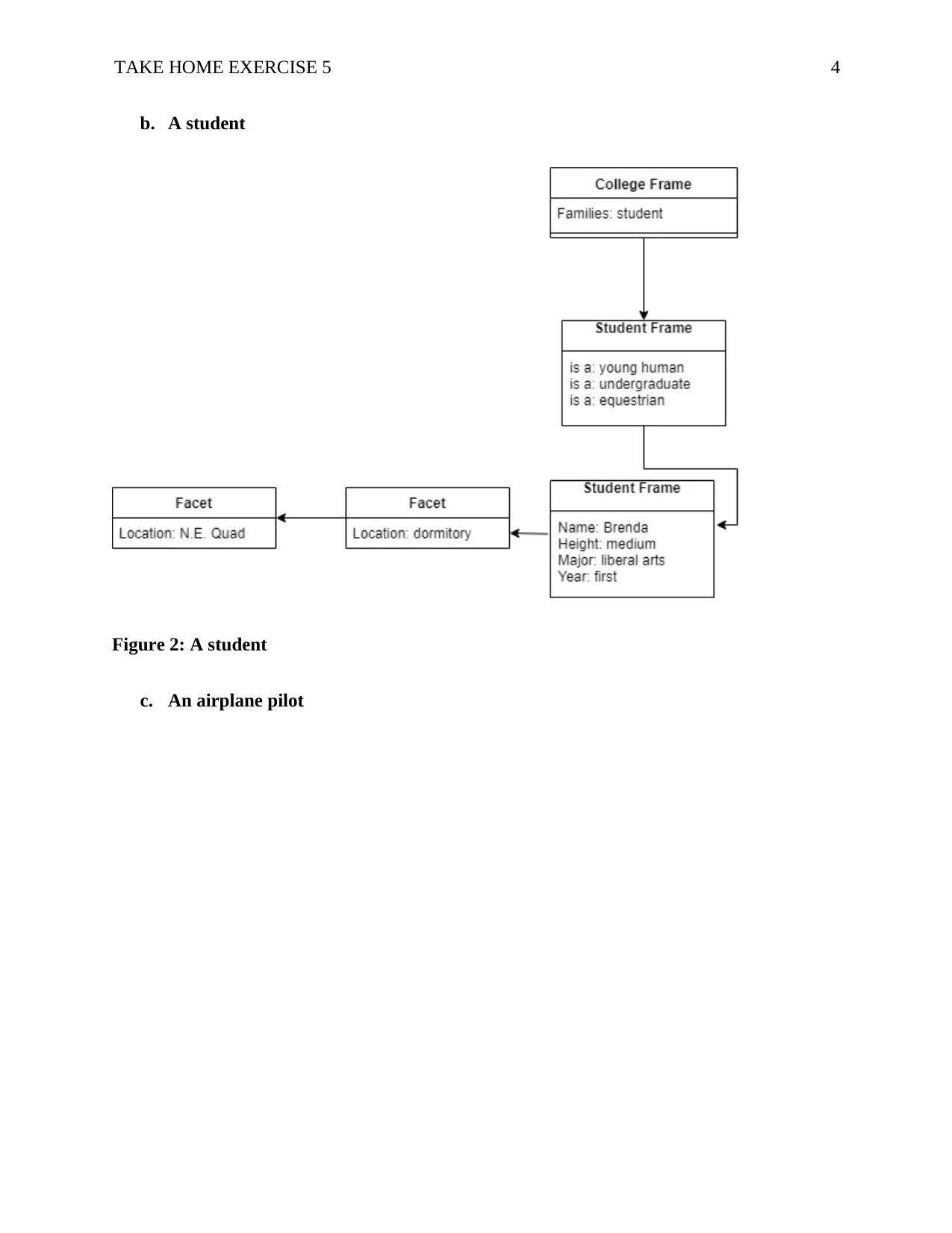
TAKE HOME EXERCISE 5 4
b. A student
Figure 2: A student
c. An airplane pilot
b. A student
Figure 2: A student
c. An airplane pilot
Paraphrase This Document
Need a fresh take? Get an instant paraphrase of this document with our AI Paraphraser
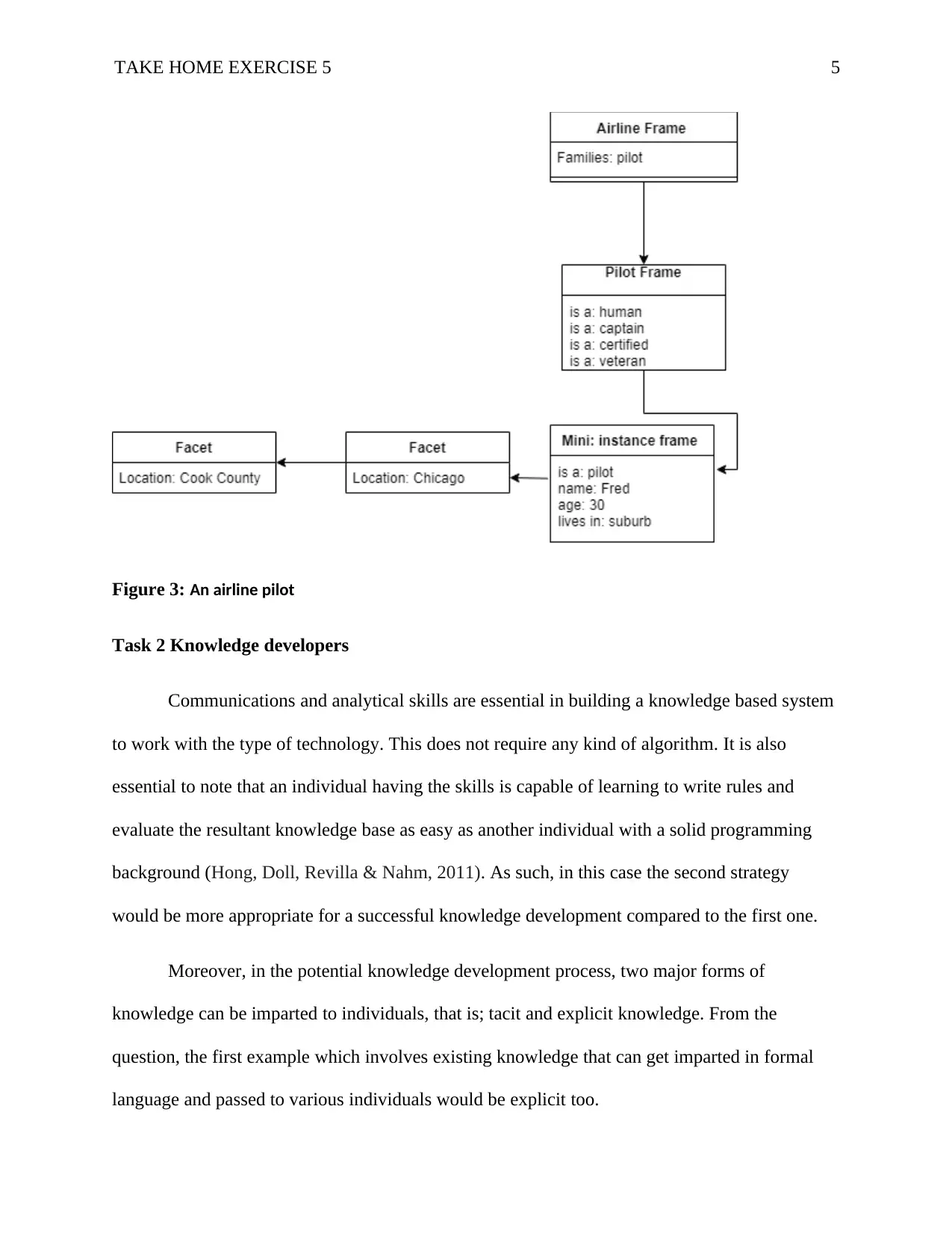
TAKE HOME EXERCISE 5 5
Figure 3: An airline pilot
Task 2 Knowledge developers
Communications and analytical skills are essential in building a knowledge based system
to work with the type of technology. This does not require any kind of algorithm. It is also
essential to note that an individual having the skills is capable of learning to write rules and
evaluate the resultant knowledge base as easy as another individual with a solid programming
background (Hong, Doll, Revilla & Nahm, 2011). As such, in this case the second strategy
would be more appropriate for a successful knowledge development compared to the first one.
Moreover, in the potential knowledge development process, two major forms of
knowledge can be imparted to individuals, that is; tacit and explicit knowledge. From the
question, the first example which involves existing knowledge that can get imparted in formal
language and passed to various individuals would be explicit too.
Figure 3: An airline pilot
Task 2 Knowledge developers
Communications and analytical skills are essential in building a knowledge based system
to work with the type of technology. This does not require any kind of algorithm. It is also
essential to note that an individual having the skills is capable of learning to write rules and
evaluate the resultant knowledge base as easy as another individual with a solid programming
background (Hong, Doll, Revilla & Nahm, 2011). As such, in this case the second strategy
would be more appropriate for a successful knowledge development compared to the first one.
Moreover, in the potential knowledge development process, two major forms of
knowledge can be imparted to individuals, that is; tacit and explicit knowledge. From the
question, the first example which involves existing knowledge that can get imparted in formal
language and passed to various individuals would be explicit too.
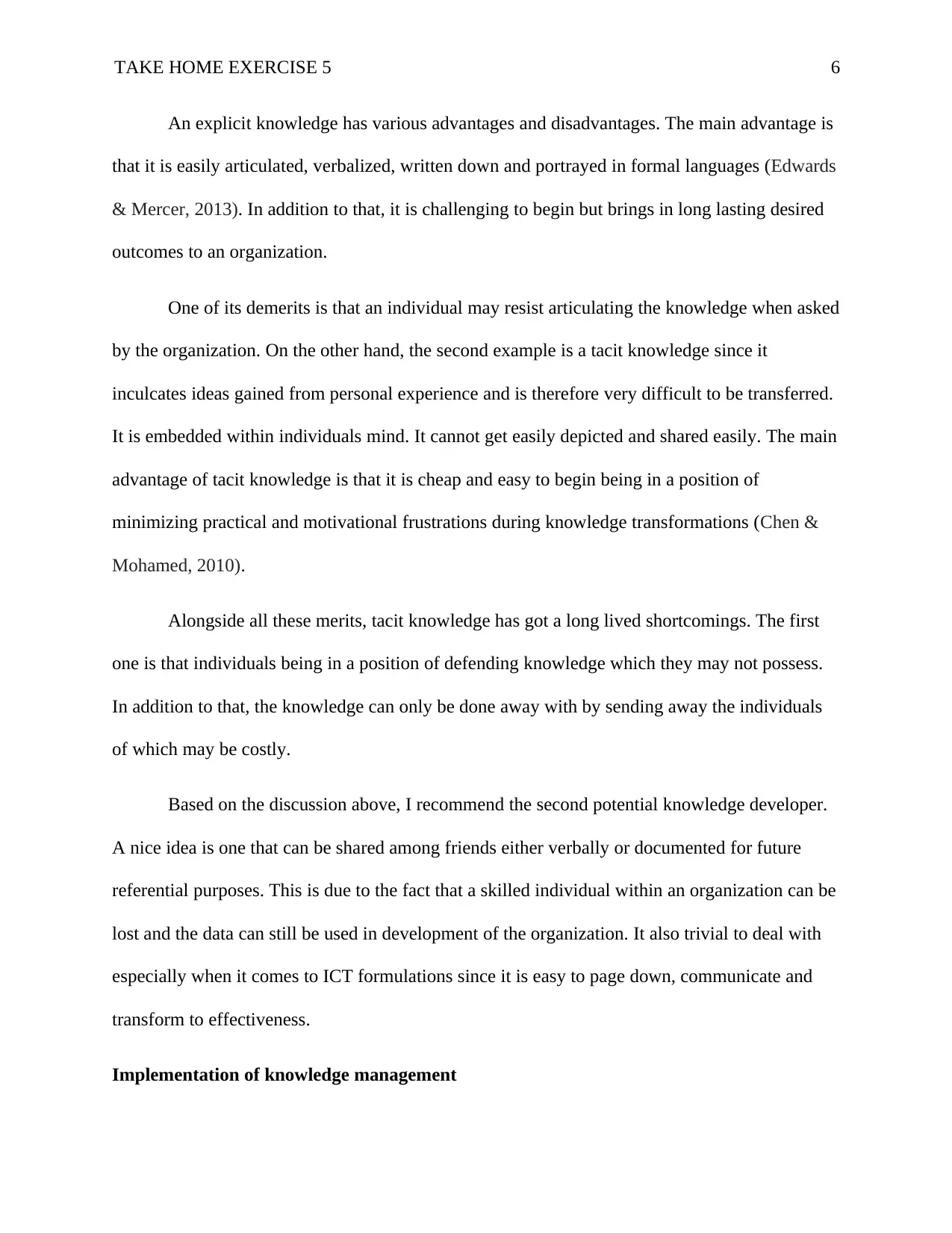
TAKE HOME EXERCISE 5 6
An explicit knowledge has various advantages and disadvantages. The main advantage is
that it is easily articulated, verbalized, written down and portrayed in formal languages (Edwards
& Mercer, 2013). In addition to that, it is challenging to begin but brings in long lasting desired
outcomes to an organization.
One of its demerits is that an individual may resist articulating the knowledge when asked
by the organization. On the other hand, the second example is a tacit knowledge since it
inculcates ideas gained from personal experience and is therefore very difficult to be transferred.
It is embedded within individuals mind. It cannot get easily depicted and shared easily. The main
advantage of tacit knowledge is that it is cheap and easy to begin being in a position of
minimizing practical and motivational frustrations during knowledge transformations (Chen &
Mohamed, 2010).
Alongside all these merits, tacit knowledge has got a long lived shortcomings. The first
one is that individuals being in a position of defending knowledge which they may not possess.
In addition to that, the knowledge can only be done away with by sending away the individuals
of which may be costly.
Based on the discussion above, I recommend the second potential knowledge developer.
A nice idea is one that can be shared among friends either verbally or documented for future
referential purposes. This is due to the fact that a skilled individual within an organization can be
lost and the data can still be used in development of the organization. It also trivial to deal with
especially when it comes to ICT formulations since it is easy to page down, communicate and
transform to effectiveness.
Implementation of knowledge management
An explicit knowledge has various advantages and disadvantages. The main advantage is
that it is easily articulated, verbalized, written down and portrayed in formal languages (Edwards
& Mercer, 2013). In addition to that, it is challenging to begin but brings in long lasting desired
outcomes to an organization.
One of its demerits is that an individual may resist articulating the knowledge when asked
by the organization. On the other hand, the second example is a tacit knowledge since it
inculcates ideas gained from personal experience and is therefore very difficult to be transferred.
It is embedded within individuals mind. It cannot get easily depicted and shared easily. The main
advantage of tacit knowledge is that it is cheap and easy to begin being in a position of
minimizing practical and motivational frustrations during knowledge transformations (Chen &
Mohamed, 2010).
Alongside all these merits, tacit knowledge has got a long lived shortcomings. The first
one is that individuals being in a position of defending knowledge which they may not possess.
In addition to that, the knowledge can only be done away with by sending away the individuals
of which may be costly.
Based on the discussion above, I recommend the second potential knowledge developer.
A nice idea is one that can be shared among friends either verbally or documented for future
referential purposes. This is due to the fact that a skilled individual within an organization can be
lost and the data can still be used in development of the organization. It also trivial to deal with
especially when it comes to ICT formulations since it is easy to page down, communicate and
transform to effectiveness.
Implementation of knowledge management
⊘ This is a preview!⊘
Do you want full access?
Subscribe today to unlock all pages.

Trusted by 1+ million students worldwide
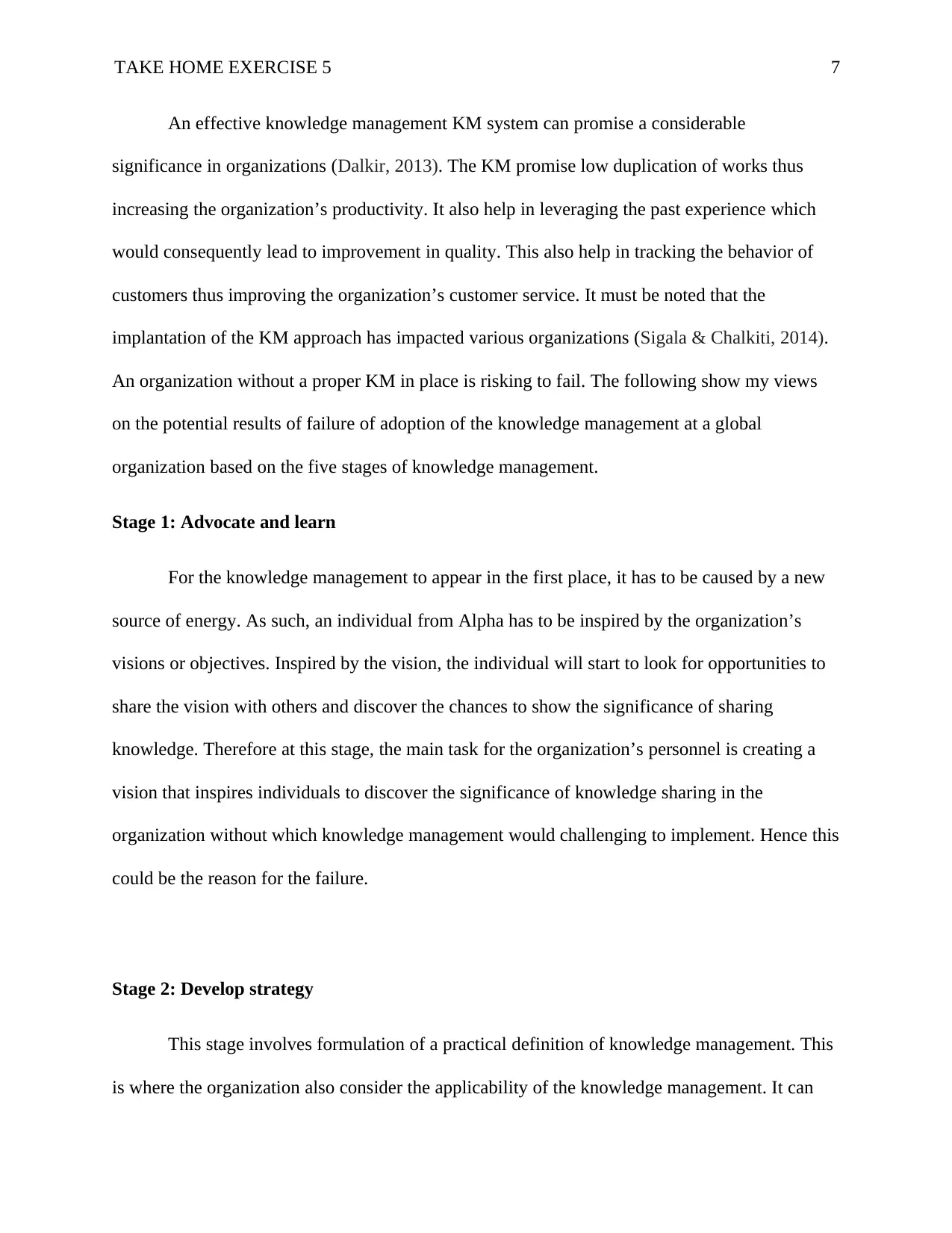
TAKE HOME EXERCISE 5 7
An effective knowledge management KM system can promise a considerable
significance in organizations (Dalkir, 2013). The KM promise low duplication of works thus
increasing the organization’s productivity. It also help in leveraging the past experience which
would consequently lead to improvement in quality. This also help in tracking the behavior of
customers thus improving the organization’s customer service. It must be noted that the
implantation of the KM approach has impacted various organizations (Sigala & Chalkiti, 2014).
An organization without a proper KM in place is risking to fail. The following show my views
on the potential results of failure of adoption of the knowledge management at a global
organization based on the five stages of knowledge management.
Stage 1: Advocate and learn
For the knowledge management to appear in the first place, it has to be caused by a new
source of energy. As such, an individual from Alpha has to be inspired by the organization’s
visions or objectives. Inspired by the vision, the individual will start to look for opportunities to
share the vision with others and discover the chances to show the significance of sharing
knowledge. Therefore at this stage, the main task for the organization’s personnel is creating a
vision that inspires individuals to discover the significance of knowledge sharing in the
organization without which knowledge management would challenging to implement. Hence this
could be the reason for the failure.
Stage 2: Develop strategy
This stage involves formulation of a practical definition of knowledge management. This
is where the organization also consider the applicability of the knowledge management. It can
An effective knowledge management KM system can promise a considerable
significance in organizations (Dalkir, 2013). The KM promise low duplication of works thus
increasing the organization’s productivity. It also help in leveraging the past experience which
would consequently lead to improvement in quality. This also help in tracking the behavior of
customers thus improving the organization’s customer service. It must be noted that the
implantation of the KM approach has impacted various organizations (Sigala & Chalkiti, 2014).
An organization without a proper KM in place is risking to fail. The following show my views
on the potential results of failure of adoption of the knowledge management at a global
organization based on the five stages of knowledge management.
Stage 1: Advocate and learn
For the knowledge management to appear in the first place, it has to be caused by a new
source of energy. As such, an individual from Alpha has to be inspired by the organization’s
visions or objectives. Inspired by the vision, the individual will start to look for opportunities to
share the vision with others and discover the chances to show the significance of sharing
knowledge. Therefore at this stage, the main task for the organization’s personnel is creating a
vision that inspires individuals to discover the significance of knowledge sharing in the
organization without which knowledge management would challenging to implement. Hence this
could be the reason for the failure.
Stage 2: Develop strategy
This stage involves formulation of a practical definition of knowledge management. This
is where the organization also consider the applicability of the knowledge management. It can
Paraphrase This Document
Need a fresh take? Get an instant paraphrase of this document with our AI Paraphraser
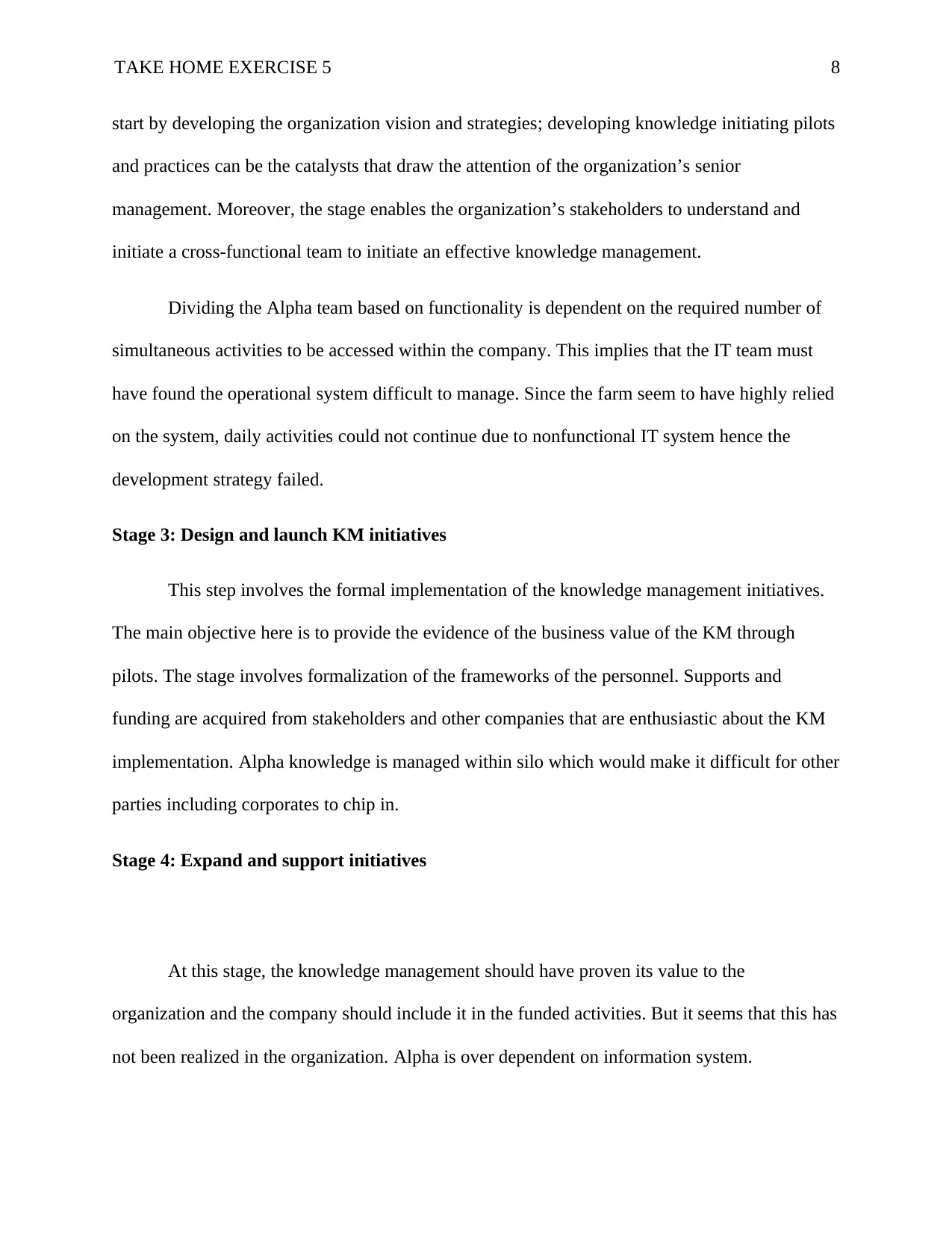
TAKE HOME EXERCISE 5 8
start by developing the organization vision and strategies; developing knowledge initiating pilots
and practices can be the catalysts that draw the attention of the organization’s senior
management. Moreover, the stage enables the organization’s stakeholders to understand and
initiate a cross-functional team to initiate an effective knowledge management.
Dividing the Alpha team based on functionality is dependent on the required number of
simultaneous activities to be accessed within the company. This implies that the IT team must
have found the operational system difficult to manage. Since the farm seem to have highly relied
on the system, daily activities could not continue due to nonfunctional IT system hence the
development strategy failed.
Stage 3: Design and launch KM initiatives
This step involves the formal implementation of the knowledge management initiatives.
The main objective here is to provide the evidence of the business value of the KM through
pilots. The stage involves formalization of the frameworks of the personnel. Supports and
funding are acquired from stakeholders and other companies that are enthusiastic about the KM
implementation. Alpha knowledge is managed within silo which would make it difficult for other
parties including corporates to chip in.
Stage 4: Expand and support initiatives
At this stage, the knowledge management should have proven its value to the
organization and the company should include it in the funded activities. But it seems that this has
not been realized in the organization. Alpha is over dependent on information system.
start by developing the organization vision and strategies; developing knowledge initiating pilots
and practices can be the catalysts that draw the attention of the organization’s senior
management. Moreover, the stage enables the organization’s stakeholders to understand and
initiate a cross-functional team to initiate an effective knowledge management.
Dividing the Alpha team based on functionality is dependent on the required number of
simultaneous activities to be accessed within the company. This implies that the IT team must
have found the operational system difficult to manage. Since the farm seem to have highly relied
on the system, daily activities could not continue due to nonfunctional IT system hence the
development strategy failed.
Stage 3: Design and launch KM initiatives
This step involves the formal implementation of the knowledge management initiatives.
The main objective here is to provide the evidence of the business value of the KM through
pilots. The stage involves formalization of the frameworks of the personnel. Supports and
funding are acquired from stakeholders and other companies that are enthusiastic about the KM
implementation. Alpha knowledge is managed within silo which would make it difficult for other
parties including corporates to chip in.
Stage 4: Expand and support initiatives
At this stage, the knowledge management should have proven its value to the
organization and the company should include it in the funded activities. But it seems that this has
not been realized in the organization. Alpha is over dependent on information system.
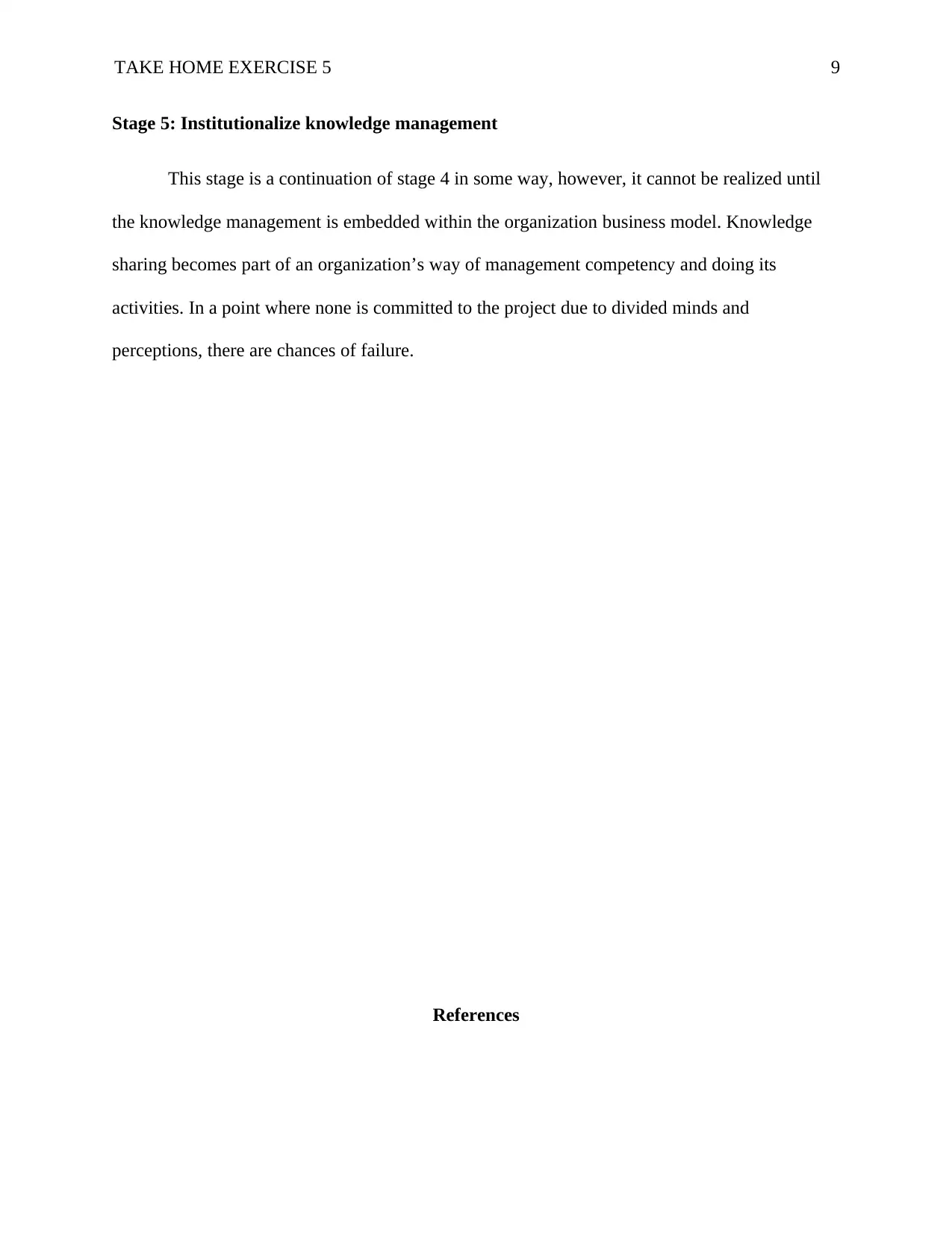
TAKE HOME EXERCISE 5 9
Stage 5: Institutionalize knowledge management
This stage is a continuation of stage 4 in some way, however, it cannot be realized until
the knowledge management is embedded within the organization business model. Knowledge
sharing becomes part of an organization’s way of management competency and doing its
activities. In a point where none is committed to the project due to divided minds and
perceptions, there are chances of failure.
References
Stage 5: Institutionalize knowledge management
This stage is a continuation of stage 4 in some way, however, it cannot be realized until
the knowledge management is embedded within the organization business model. Knowledge
sharing becomes part of an organization’s way of management competency and doing its
activities. In a point where none is committed to the project due to divided minds and
perceptions, there are chances of failure.
References
⊘ This is a preview!⊘
Do you want full access?
Subscribe today to unlock all pages.

Trusted by 1+ million students worldwide
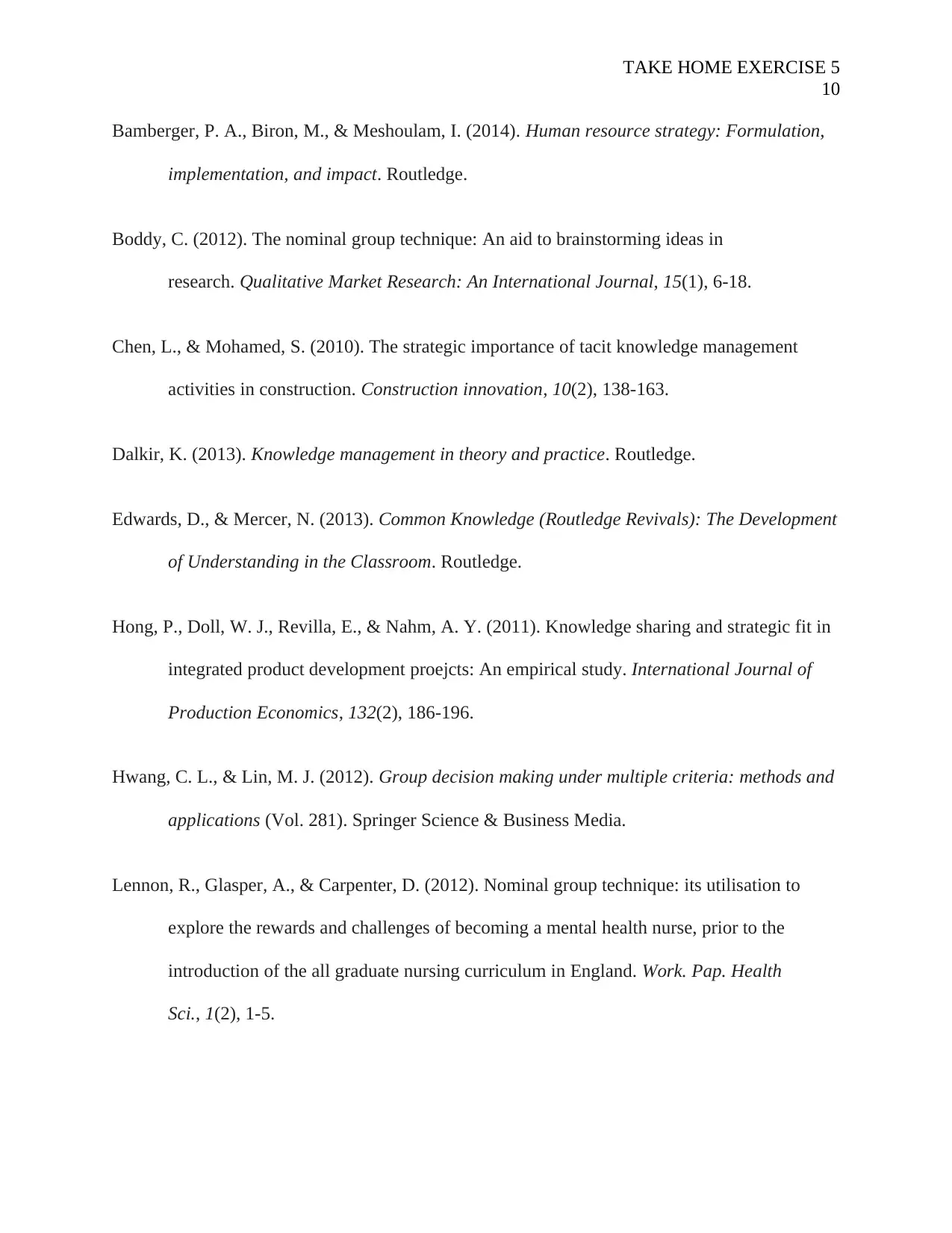
TAKE HOME EXERCISE 5
10
Bamberger, P. A., Biron, M., & Meshoulam, I. (2014). Human resource strategy: Formulation,
implementation, and impact. Routledge.
Boddy, C. (2012). The nominal group technique: An aid to brainstorming ideas in
research. Qualitative Market Research: An International Journal, 15(1), 6-18.
Chen, L., & Mohamed, S. (2010). The strategic importance of tacit knowledge management
activities in construction. Construction innovation, 10(2), 138-163.
Dalkir, K. (2013). Knowledge management in theory and practice. Routledge.
Edwards, D., & Mercer, N. (2013). Common Knowledge (Routledge Revivals): The Development
of Understanding in the Classroom. Routledge.
Hong, P., Doll, W. J., Revilla, E., & Nahm, A. Y. (2011). Knowledge sharing and strategic fit in
integrated product development proejcts: An empirical study. International Journal of
Production Economics, 132(2), 186-196.
Hwang, C. L., & Lin, M. J. (2012). Group decision making under multiple criteria: methods and
applications (Vol. 281). Springer Science & Business Media.
Lennon, R., Glasper, A., & Carpenter, D. (2012). Nominal group technique: its utilisation to
explore the rewards and challenges of becoming a mental health nurse, prior to the
introduction of the all graduate nursing curriculum in England. Work. Pap. Health
Sci., 1(2), 1-5.
10
Bamberger, P. A., Biron, M., & Meshoulam, I. (2014). Human resource strategy: Formulation,
implementation, and impact. Routledge.
Boddy, C. (2012). The nominal group technique: An aid to brainstorming ideas in
research. Qualitative Market Research: An International Journal, 15(1), 6-18.
Chen, L., & Mohamed, S. (2010). The strategic importance of tacit knowledge management
activities in construction. Construction innovation, 10(2), 138-163.
Dalkir, K. (2013). Knowledge management in theory and practice. Routledge.
Edwards, D., & Mercer, N. (2013). Common Knowledge (Routledge Revivals): The Development
of Understanding in the Classroom. Routledge.
Hong, P., Doll, W. J., Revilla, E., & Nahm, A. Y. (2011). Knowledge sharing and strategic fit in
integrated product development proejcts: An empirical study. International Journal of
Production Economics, 132(2), 186-196.
Hwang, C. L., & Lin, M. J. (2012). Group decision making under multiple criteria: methods and
applications (Vol. 281). Springer Science & Business Media.
Lennon, R., Glasper, A., & Carpenter, D. (2012). Nominal group technique: its utilisation to
explore the rewards and challenges of becoming a mental health nurse, prior to the
introduction of the all graduate nursing curriculum in England. Work. Pap. Health
Sci., 1(2), 1-5.
Paraphrase This Document
Need a fresh take? Get an instant paraphrase of this document with our AI Paraphraser
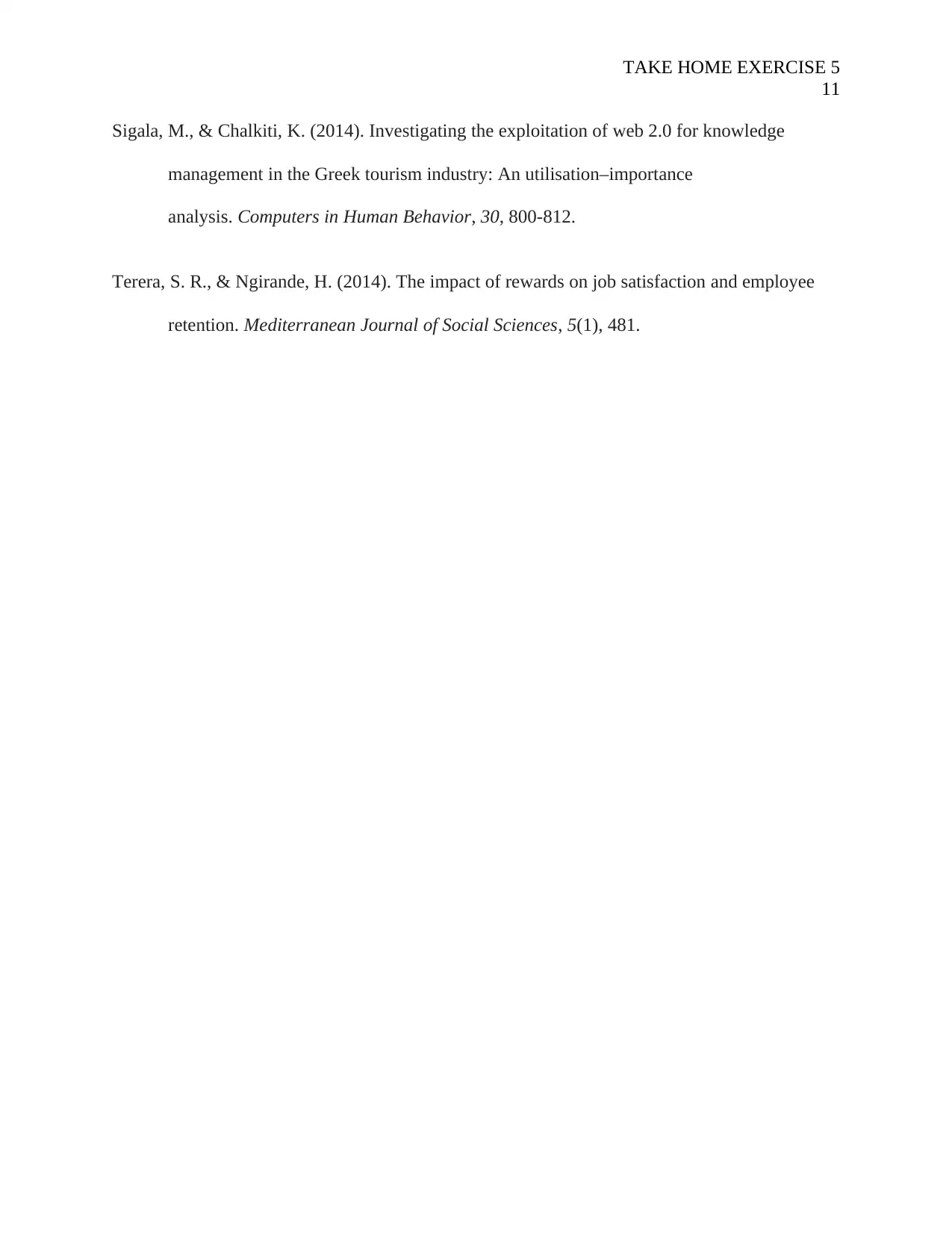
TAKE HOME EXERCISE 5
11
Sigala, M., & Chalkiti, K. (2014). Investigating the exploitation of web 2.0 for knowledge
management in the Greek tourism industry: An utilisation–importance
analysis. Computers in Human Behavior, 30, 800-812.
Terera, S. R., & Ngirande, H. (2014). The impact of rewards on job satisfaction and employee
retention. Mediterranean Journal of Social Sciences, 5(1), 481.
11
Sigala, M., & Chalkiti, K. (2014). Investigating the exploitation of web 2.0 for knowledge
management in the Greek tourism industry: An utilisation–importance
analysis. Computers in Human Behavior, 30, 800-812.
Terera, S. R., & Ngirande, H. (2014). The impact of rewards on job satisfaction and employee
retention. Mediterranean Journal of Social Sciences, 5(1), 481.
1 out of 11
Related Documents
Your All-in-One AI-Powered Toolkit for Academic Success.
+13062052269
info@desklib.com
Available 24*7 on WhatsApp / Email
![[object Object]](/_next/static/media/star-bottom.7253800d.svg)
Unlock your academic potential
Copyright © 2020–2025 A2Z Services. All Rights Reserved. Developed and managed by ZUCOL.


